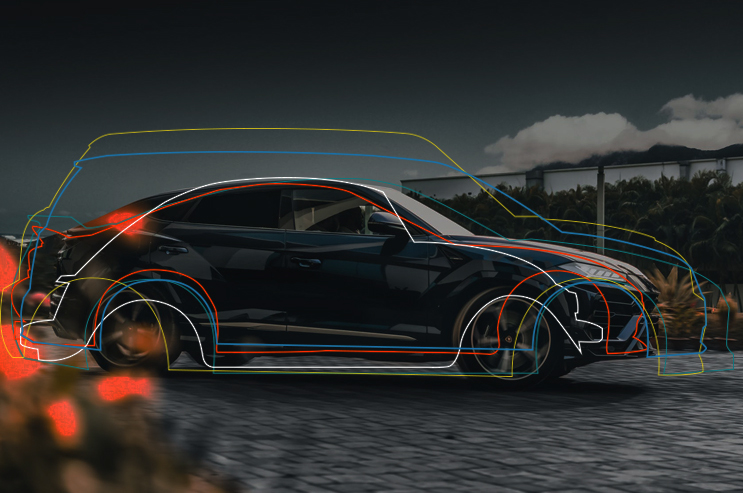

Honda Fit – Ooizine Guide Photo
Among all types of bodywork on the market, the hatchback is one of the most popular. The word hatch in English means hatch and comes from the idea of the rear door opening upwards and giving access to the trunk and interior of the vehicle. This category has 2 distinct volumes that are easily recognizable: the engine compartment and the passenger compartment integrated into the trunk. They are offered in 2-door and 4-door versions (3 and 5 if you count the trunk door) and are generally the simplest version of the car lines.
As examples of hatchback sold in Japan we have: Toyota Prius (learn a little about the history of this popular hybrid here on Wikipedia), Nissan March and Note and Honda Fit
Toyota Crown Athlete G – Photo Ooizine Guide
O then ( silk) is the most traditional version of the car body types and has 3 distinct volumes: engine compartment, passenger cabin and trunk separated from the passenger compartment. They are offered in 4-door versions and the tailgate does not include the rear window.
As examples of sedans sold in Japan we have: Toyota Camry and Crown, Subaru Legacy, Honda Acord.
Mercedes AMG Coupe – Photo Mike Bird
0s Coupés have the more classic format in 2 volumes but less space for passengers (when they offer seats in the back) and rear compartments. It's a middle ground between a sedan and a roadster. In general it offers good aerodynamics and performance.
As examples of coupes sold in Japan we have: Audi TT, Mazda RX-8, Toyota 86, Infiniti Q60
Toyota Alphard – Photo Guide Ooizine
Is called minivan for its construction where passenger space, engine compartment and trunk form a single unit. All in favor of practicality and rational use of internal space.
As examples of minivans sold in Japan we have: Toyota Voxy and Estima, Nissan Serena, Honda Step Wagon
BMW X6 – Photo Pixabay
SUV comes from English and means Sport Utility Vehicle or "Sports Utility Vehicle” in free translation into Portuguese. Its proposal is to be a vehicle both for off-road use and for use on roads and cities. They usually combine a powerful engine, high bodywork and refined interior.
As examples of SUVs sold in Japan we have: Mitsubishi Pajero, Ford Explorer, Toyota Land Cruiser, Lexus LX, BMW X6
Toyota Hiace – Photo Guia Ooizine
As vans are vehicles designed to transport the largest possible number of people within a platform considered to be a car. For this reason, luggage space and aerodynamic lines are compromised in most models. You vans are derived from vans but with an interior dedicated exclusively to the transport of loads, that is, the passenger seats are removed to open up more useful space.
As examples of vans sold in Japan we have: Nissan Caravan, Toyota Hiace.
fastback
Fastbacks are derived from hatchbacks but have a longer rear part, which adds elegance to the car's lines. The roofline runs in a gentle curve to the trunk.
Examples of fastbacks sold in Japan include: Mercedes AMG GT, Jaguar F-Type, Audi A7, Toyota Celica, Honda Accord
ROADSTERS
This model is for those who like roads, fun and power. Must have front engine, rear wheel drive and 2 seats.
Examples of roadsters sold in Japan include: Mazda MX-5, Nissan 370Z Roadster, BMW Z4.
PICK UP
The term Pick-up comes from English and literally means to carry. Its primary purpose is to provide an open space to facilitate the loading and unloading of cargo. The basic structure consists of a seat for driver and passenger (there are double cab models on the market), rigid roof and bucket for cargo.
Examples of pickups sold in Japan include: Toyota Hilux Pickup, Nissan Frontier, Mitsubishi Triton
STATION WAGON OR STATION WAGON
They are models derived from sedans that focus on functionality and access to the trunk, in addition to comfort for passengers in the back seat. They offer more luggage space in the trunk and a rear window integrated into the trunk lid for easy access.
Examples of station wagons sold in Japan include: Toyota Corolla Fielder, Subaru Legacy, Nissan Wingroad.
CROSSOVERS
Crossovers are vehicles derived from a passenger car platform but with changes and adaptations that make it look like an SUV. The biggest difference between these two models appears in relation to the monoblock chassis and bodywork of the crossovers and the use of truck-based chassis by the legitimate SUVs.
Examples of crossovers sold in Japan include: Mazda CX-3, Subaru Outback, Honda HR-V, Nissan X-trail
These are the most common body models today. Do you have a preference? Share this story and look for your next car on Mercauto Car Portal from the Ooizine Guide. There are several offers and information about the best car shops in Gunma, Saitama, Tochigi and Ibaraki.
Access now the Mercauto Portal and find stores or a vehicle that's right for you.
Choose your language